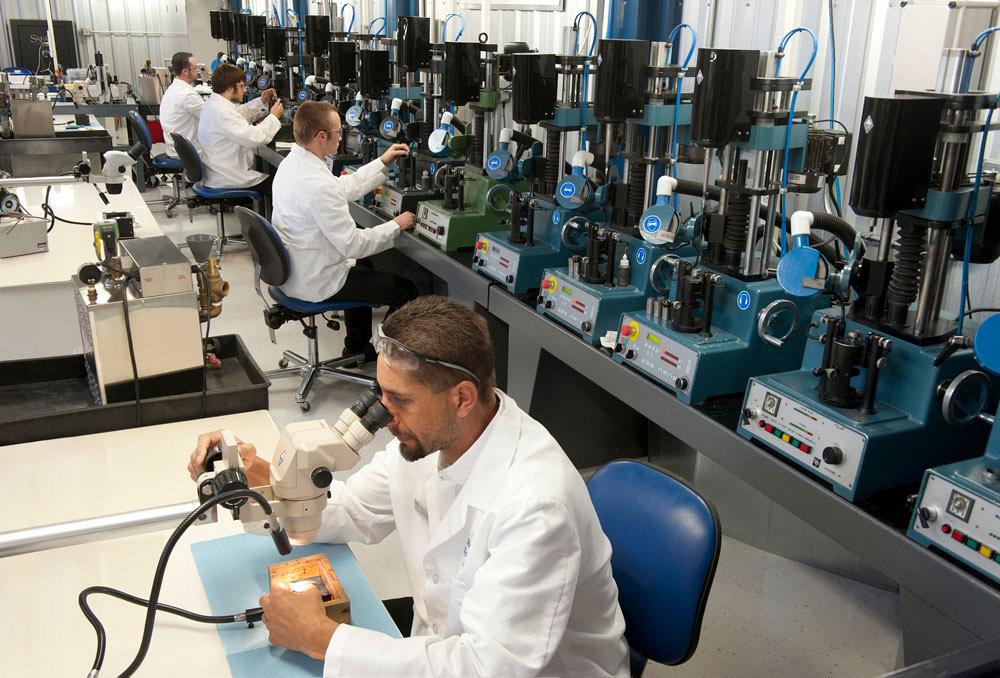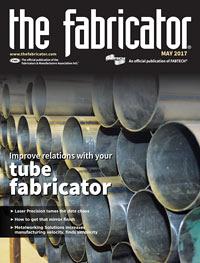Editor-in-Chief
- FMA
- The Fabricator
- FABTECH
- Canadian Metalworking
Categories
- Additive Manufacturing
- Aluminum Welding
- Arc Welding
- Assembly and Joining
- Automation and Robotics
- Bending and Forming
- Consumables
- Cutting and Weld Prep
- Electric Vehicles
- En Español
- Finishing
- Hydroforming
- Laser Cutting
- Laser Welding
- Machining
- Manufacturing Software
- Materials Handling
- Metals/Materials
- Oxyfuel Cutting
- Plasma Cutting
- Power Tools
- Punching and Other Holemaking
- Roll Forming
- Safety
- Sawing
- Shearing
- Shop Management
- Testing and Measuring
- Tube and Pipe Fabrication
- Tube and Pipe Production
- Waterjet Cutting
Industry Directory
Webcasts
Podcasts
FAB 40
Advertise
Subscribe
Account Login
Search
Technology Spotlight: Removing rubies and sapphires from the waterjet mix
Diamond Technology Innovations wants to ween fabricators off the use of cheaper materials used in waterjet orifices
- By Dan Davis
- May 5, 2017
- Article
- Waterjet Cutting

Figure 1
The new tetraCORE™ orifice material is designed to last 10 to 15 times longer than ruby and sapphire orifices. Standard sizes for the orifices are 0.005 to 0.016 in.
In the waterjet world, rubies and sapphires aren’t that valuable.
At a certain time in history, these materials may have been looked upon as a sign of prestige and wealth. Today, in the manufacturing world, they are a basic consumable in waterjet cutting.
To be more exact, rubies and sapphires are often used in waterjet orifice designs. The ultra-high, pressurized water in a waterjet cutting system passes through a jewel orifice to focus the jet stream that with water alone, or in combination with an abrasive, like garnet, to cut metal, composites, rubber, food, and other materials. Rubies and sapphires are truly the opposite of valuable in that they cost between $15 and $25 per piece and typically last for only 20 to 40 hours of waterjet cutting. In fact, if these ruby or sapphire orifices are not properly installed in a clean environment or if there is debris within high-pressure lines from recent maintenance, can chip, fracture, and fail instantly upon first use.
Simply put, rubies and sapphires aren’t that strong. Sapphires, produced with sharp edge technology, can help to deliver long, coherent jet streams for waterjet cutting, but they are highly vulnerable to impacts from debris traveling within the system. Rubies with a larger inlet flare are manufactured to be a tad more robust than sapphires to handle abrasive cutting. They deliver shorter, more turbulent jet streams. They are susceptible to instant damage from particle impact. Also, because sapphire and ruby material erodes over time of use, operators are left with lost jet stream coherency, which results in reduced edge cut quality, slower cutting speeds, and significantly reduced tolerances. If not replaced in a timely manner, a worsened jet stream can lead to early wear of the cutting head internal components and the abrasive focusing nozzle, which might mean an earlier-than-expected cutting head replacement.
That’s where diamond orifices come into play. While they cost about $425 or more, they last a minimum of 500 hours of waterjet use. That is especially noteworthy as it minimizes the downtime associated with changing out waterjet orifices. In addition, the significantly harder, more robust material ensures tight tolerances are kept consistent throughout the product’s life.
Metal fabricators are now beginning to understand the importance of keeping the waterjet system running as much as possible, and they are showing more interest in diamond orifices. So much so that waterjet system manufacturers are putting diamond orifices—instead of ruby or sapphire orifices that have been used for years—into the new systems they sell.
The folks who work for Diamond Technology Innovations (dti™), which manufactures waterjet orifices, like that trend, but they’d like to see rubies and sapphires disappear altogether from the waterjet landscape.
“As the waterjet industry grows, we need better technology. We need longer life and increased efficiencies,” said Jessica Van Hatcher, the company’s director of marketing and business development. “That’s the only way that we can compete with other cutting technologies, like plasma and laser.”
That’s why dti has introduced a new, lab-grown material (see Figure 1) that is positioned as a stepping stone from rubies and sapphires. The new product, tetraCORE™, is priced to entice fabricators to make that jump to a material that demonstrates considerably longer life and better cutting performance than rubies and sapphires.
Engineering a New Way
This new development is something that could be expected from a company founded by Ted Jernigan. He started his own waterjet company, H2O Jet, in 1992 after installing and troubleshooting waterjet systems for a major waterjet system manufacturer for 12 years. He realized the shortcomings associated with using the unpredictable ruby and sapphire waterjet orifices and began to focus on diamond orifice manufacturing.
Jernigan spun off dti as a separate company in 2004 and sold H2O Jet in 2006. dti’s business focus was solely on orifice manufacturing for high-pressure waterjet systems, and it left them with a key question to answer.
“What we noticed was that our diamond business was growing, but that we really would have liked to see rubies and sapphires out of the picture completely,” Van Hatcher said. “How do we get rid of this product that is slowing our market down?”
That answer led to the debut of tetraCORE, the first new orifice material developed and introduced into the waterjet industry in more than 30 years, according to dti officials. The new material was sold through an exclusive dealer in 2016. Now the product is available to be sold by others.
The new material was developed using a tetrahedral, molecularly bonded material, which exhibits hardness characteristics similar to diamond, according to Perry Hanchey, dti’s general manager.
“tetraCORE is a binderless material,” Hanchey added, “which eliminates water or chemicals from being able to erode or breakdown the material, even in harsh, high-pressure abrasive waterjet environments.”
The proprietary material is provided to dti, which then cuts, shapes and polishes it to precise specifications, transforming the material into waterjet orifices (see Figure 2).
Hanchey said tetraCORE lasts about 10 to 15 times longer than rubies and sapphires. He also said that fabricators that use this product will find that the cutting stream stays more consistent, resulting in longer life of their waterjet cutting head components and mixing tubes.
The company has set the suggested retail price for the new orifice material at $149 each. The idea is that, when considering the total cost of running a waterjet with the new orifices, the fabricator will be paying about the same he is now if he is using a ruby or sapphire orifice. For example, if those ruby or sapphire orifices are being sold for about $15 a piece and the new tetraCORE product is expected to last at least 10 times longer, fabricators shouldn’t be too shocked about paying the suggested price.
In the meantime, the fabricators not yet ready to commit to diamond orifices can take advantage of the new product thanks to 30-day trials that dti offers.
“When end users try tetraCORE, they turn into repeat customers. The product sells itself once a user experiences the benefits and cost savings first hand,” Hanchey said.
Herb Schwerdel, facility manager, Hesco Armor, said he has no desire to go back to using ruby- or sapphire-based orifices. His company cuts body armor made of a combination of composite-type material and metal for fabricating different fixtures on the company’s waterjet in a 15,000-sq.-ft. facility in Aberdeen, Wash. He used the cheaper orifices because that’s what came with the 30-HP, 60,000-PSI waterjet that Hesco Armor, then known as Reed Composite Solutions, installed in 2012.
“You never knew whether they would last five hours or 45 hours,” Schwerdel said.
On the advice of his garnet supplier, Schwerdel tried the tetraCORE orifices. After some initial trials with the new product, Schwerdel got the system dialed in and he watched it go—for more than 500 hours before it needed to be replaced. That was when the facility was running at 24 hours a day.
Today Schwerdel said he also measures the lifespan of these new orifices based on a common maintenance milestone: changing mixing tubes in the cutting head.
“These mixing tubes last about 120 hours,” he said. “I could go through about five mixing tubes before having to worry about the orifices.” When he is in there changing out the tube, Schwerdel said he takes the opportunity to clean the orifice. That’s about the only time he has to get up-close with the orifice while it’s in use; it wasn’t like that with the other products in the beginning of his waterjet cutting career.
“Without the right orifices, you get a bad waterjet stream,” Schwerdel said. “I went through 19 ruby orifices one time before I could get a good stream.”
Diamond Technology Innovations, 360-866-1337, www.dtiinside.com
About the Author

Dan Davis
2135 Point Blvd.
Elgin, IL 60123
815-227-8281
Dan Davis is editor-in-chief of The Fabricator, the industry's most widely circulated metal fabricating magazine, and its sister publications, The Tube & Pipe Journal and The Welder. He has been with the publications since April 2002.
subscribe now

The Fabricator is North America's leading magazine for the metal forming and fabricating industry. The magazine delivers the news, technical articles, and case histories that enable fabricators to do their jobs more efficiently. The Fabricator has served the industry since 1970.
start your free subscription- Stay connected from anywhere

Easily access valuable industry resources now with full access to the digital edition of The Fabricator.

Easily access valuable industry resources now with full access to the digital edition of The Welder.

Easily access valuable industry resources now with full access to the digital edition of The Tube and Pipe Journal.
- Podcasting
- Podcast:
- The Fabricator Podcast
- Published:
- 04/16/2024
- Running Time:
- 63:29
In this episode of The Fabricator Podcast, Caleb Chamberlain, co-founder and CEO of OSH Cut, discusses his company’s...
- Trending Articles
Capturing, recording equipment inspection data for FMEA

Tips for creating sheet metal tubes with perforations

Are two heads better than one in fiber laser cutting?

Supporting the metal fabricating industry through FMA

Hypertherm Associates implements Rapyuta Robotics AMRs in warehouse

- Industry Events
16th Annual Safety Conference
- April 30 - May 1, 2024
- Elgin,
Pipe and Tube Conference
- May 21 - 22, 2024
- Omaha, NE
World-Class Roll Forming Workshop
- June 5 - 6, 2024
- Louisville, KY
Advanced Laser Application Workshop
- June 25 - 27, 2024
- Novi, MI



























